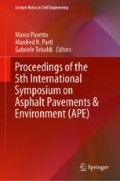Abstract
This paper explains the effect of air void topology on the hydraulic conductivity and clogging properties of pervious asphalt. Cylinders of asphalt mixtures with a single type of aggregates and five gradations have been manufactured, Computed Tomography (CT) scanned and, transparent resin blocks with equivalent pore structure have been 3D printed to allow the visual inspection and quantification of the clogs. Geometrical properties, such as the macroporosity, air void diameter, Euler number and tortuosity, have been recorded from the CT scans. Furthermore, the hydraulic conductivity and clogging susceptibility of the asphalt cylinders and 3D-printed resin blocks have been measured.
It has been found that the air void diameter and porosity are the parameters that most affect the movement of water and solids through the porous asphalt. In the mixtures studied in this paper, these two parameters can be directly correlated to the tortuosity and Euler number of the asphalt mixtures. Higher macroporosity implies higher hydraulic conductivity so as lower clogging susceptibility.
In order to use the results of this paper to design new pervious pavements, further research is required where the clogging properties of mixtures with a wider range of aggregate gradations, maximum sizes and geometries is studied.
Access this chapter
Tax calculation will be finalised at checkout
Purchases are for personal use only
References
Aboufoul M, Garcia A (2016) Factors affecting the hydraulic conductivity of asphalt mixture. Mater Struct 50(2):116
Aboufoul M, Chiarelli A, Triguero I, Garcia A (2018) Virtual asphalt to predict road’s air voids and hydraulic conductivity. https://doi.org/10.20944/preprints201810.0710.v1. ppr: ppr61080
Ahmad N (2011) Asphalt mixture moisture sensitivity evaluation using surface energy parameters. Ph.D. thesis in Civil Engineering, University of Nottingham
Arganda-Carreras I, Fernandez-Gonzalez R, Munoz-Barrutia A, Ortiz-De-Solorzano C (2010) 3D reconstruction of histological sections: application to mammary gland tissue. Microsc Res Tech 73(11):1019–1029
Bacher M (2013) 3D-printing of undisturbed soil imaged by X-ray. Master’s thesis in Environmental Science, Upsala University
BS EN 12697-33, B.S.I.B. (2003) Bituminous Mixtures, Test Methods for Hot Mix Asphalt: Specimen prepared by roller compactor
Doube M, Kłosowski MM, Arganda-Carreras I, Cordeliéres F, Dougherty RP, Jackson J, Schmid B, Hutchinson JR, Shefelbine SJ (2010) BoneJ: free and extensible bone image analysis in ImageJ. Bone 47:1076–1079
Fwa T, Lim E, Tan S (2014) Comparison of permeability and clogging characteristics of porous asphalt and pervious concrete pavement materials. Transp Res Rec J Transp Res Board 2511:72–80
Guwe Y, Fwa T, Tan S (1999) Laboratory evaluation of clogging potential of porous asphalt mixtures. Transp Res Rec J Transp Res Board 1681:43–49
Hassan N, Abdullah N, Shukry N, Mahmud M, Yunus N, Putrajaya R, Hainin M, Yaacob H (2015) Laboratory evaluation of clogging behaviour of porous asphalt pavements. J Teknologi 76(14)
Ishutov S et al (2017) Using resin-based 3D printing to build geometrically accurate proxies of porous sedimentary rocks. Groundwater 56(3):482–490
Matsuda T, Inagaki T, Masuyama Y (1998) Investigation and examination concerning function recovery of drainage asphalt pavement. In: 9th Road Engineering Association of Asia and Austalasia (REAAA) Conference, Wellington, New Zealand
Nicholls JC (1997) Review of UK Porous Asphalt Trials, Thomas Telford
Sandberg U (1987) Tire/road noise – studies of the mechanisms of noise generation, methods of measurement and road surface characterization. Linköping Studies in Science and Technology, Dissertations 166, Department of Physics and Measurement Technology, Linköping University, Linköping
Taylor M, Boudreau H III, Huang T, Tatel S, Najafi F (2009) The real world advantages and disadvantages of permeable pavements as roadways. Int J Interdiscip Soc Sci Annu Rev 4(1):341–354
Yong C, McCarthy D, Deletic A (2013) Predicting physical clogging of porous and permeable pavements. J Hydrol 481:48–55
Acknowledgements
The authors would like to acknowledge the University of Nottingham, which has funded part of this research through the Dean of Engineering Research Scholarship for International Excellence.
Author information
Authors and Affiliations
Corresponding author
Editor information
Editors and Affiliations
Rights and permissions
Copyright information
© 2020 Springer Nature Switzerland AG
About this paper
Cite this paper
Garcia, A., Aboufoul, M., Gerami, K., Asamoah, F. (2020). Effect of Air Void Topology on the Hydraulic Conductivity and Clogging Properties of Pervious Asphalt Roads. In: Pasetto, M., Partl, M., Tebaldi, G. (eds) Proceedings of the 5th International Symposium on Asphalt Pavements & Environment (APE). ISAP APE 2019. Lecture Notes in Civil Engineering, vol 48. Springer, Cham. https://doi.org/10.1007/978-3-030-29779-4_37
Download citation
DOI: https://doi.org/10.1007/978-3-030-29779-4_37
Published:
Publisher Name: Springer, Cham
Print ISBN: 978-3-030-29778-7
Online ISBN: 978-3-030-29779-4
eBook Packages: EngineeringEngineering (R0)

